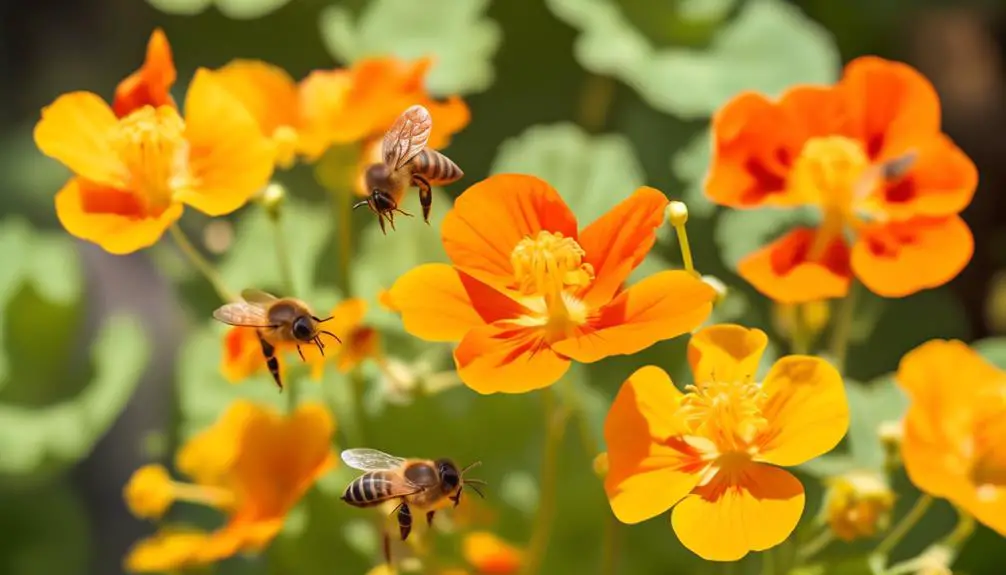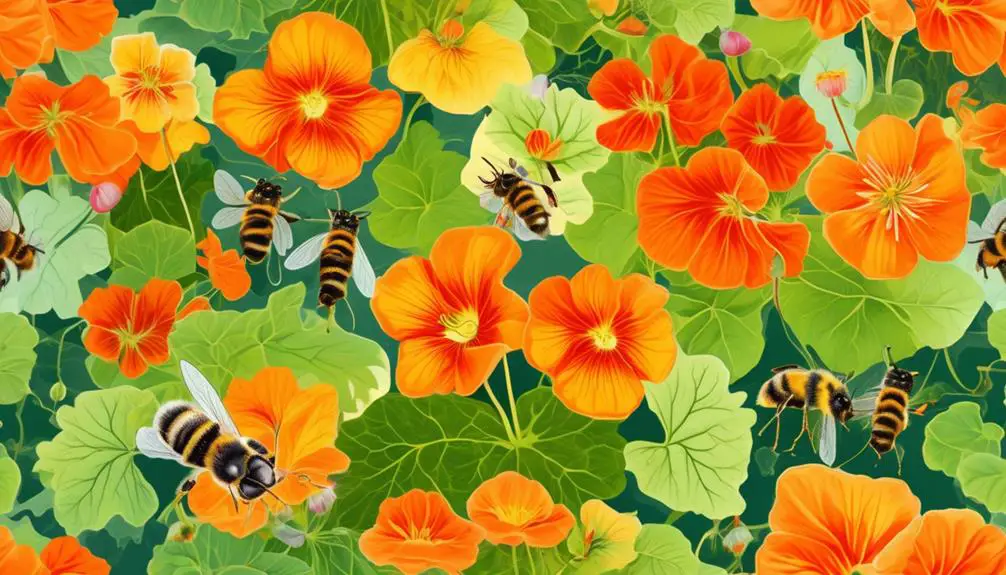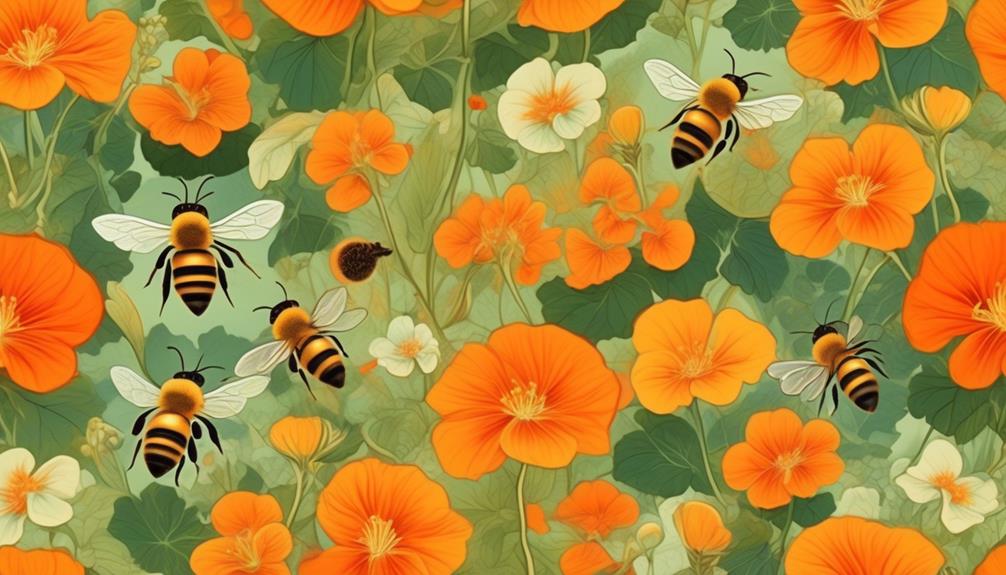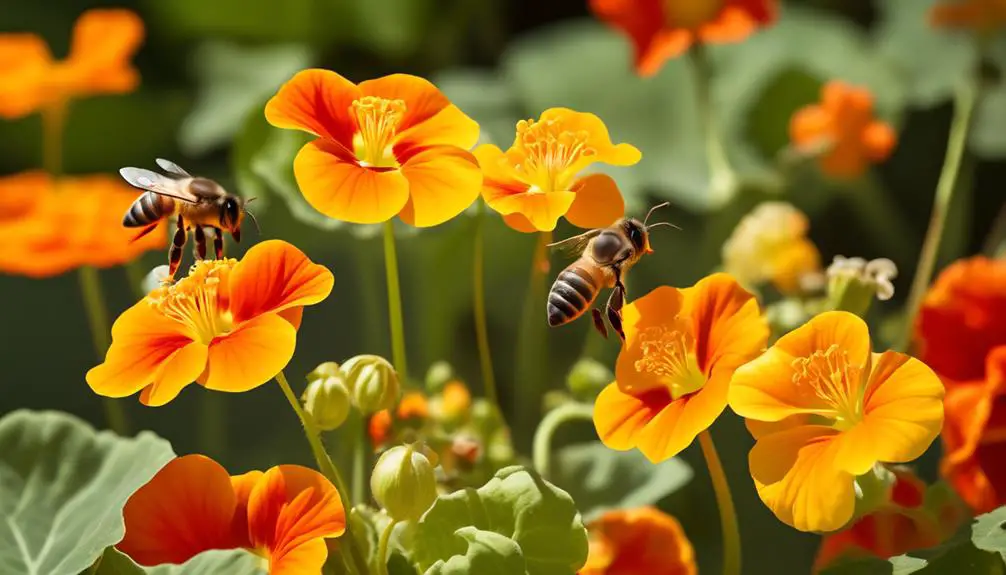Buzz into the world of honey bees and discover how the colorful nasturtiums in your garden play a crucial role in their survival.

Are Nasturtiums Good for Honey Bees
If you've ever thought, 'I'm a bee, I need a vacation,' then you're not alone, even bees need a break.
Considering this, you might wonder if your garden could serve as a kind of all-inclusive resort for honey bees. One potential candidate for this is the beautiful and versatile nasturtium. Known for its vibrant blooms and easy-to-grow nature, it's a common sight in gardens.
But does it really benefit honey bees? As we explore this topic, you'll discover the relationship between these industrious insects and this popular plant, an understanding that might just change the way you look at your garden.
Key Takeaways
- Nasturtiums serve as a significant nectar source for honey bees due to their high-sugar content and long flowering period.
- The benefits of nasturtiums to honey bee health include providing high-energy nectar, protein-rich pollen, and consistent food sources that support hive stability and reduce starvation risks.
- Bees play a crucial role in pollinating nasturtiums, aiding in their reproduction and ensuring their survival.
- Proper planting and care practices for nasturtiums, such as well-drained soil, full sun exposure, and pest monitoring without chemical pesticides, can help support both the plant and bee populations.
Understanding Nasturtiums and Their Characteristics

Diving into the world of nasturtiums, you'll find these vibrant plants aren't only striking in appearance but also carry a host of distinctive characteristics worth noting. Belonging to the Tropaeolaceae family, nasturtiums are known for their bold, round leaves and bright, trumpet-shaped flowers. But it's not just their aesthetic appeal that's remarkable.
Scientifically speaking, nasturtiums are unique for their high content of lutein, a plant pigment associated with eye health. They're also rich in vitamin C, providing a boost to the immune system. Interestingly, all parts of the nasturtium plant are edible, emitting a peppery taste similar to arugula or watercress.
Furthermore, nasturtiums exhibit a peculiarity in their growing habit. They prefer poor soil conditions and tend to produce more leaves than flowers when supplied with excess nutrients. This trait is a survival adaptation, allowing nasturtiums to thrive in diverse environments.
Lastly, these plants have a symbiotic relationship with bees. Their nectar-rich flowers attract bees, aiding in the process of pollination. In return, the bees help nasturtiums to propagate, ensuring their survival. Understanding these characteristics is essential to appreciating the unique role nasturtiums play in our ecosystem.
The Importance of Bees in Pollination

You mightn't realize it, but bees, particularly honey bees, play a pivotal role in pollination, a crucial process for the reproduction of many plant species, including nasturtiums. These industrious creatures flit from flower to flower, collecting nectar and pollen. As they do so, they inadvertently transfer pollen grains from the male parts of a flower (the anthers) to the female parts (the stigma) of the same or another flower.
This process, known as pollination, is essential for plant fertilization. It's through this fertilization that plants produce seeds and fruits, thereby ensuring their survival and propagation. In this respect, bees are vital workers in nature's factory, aiding in the production of much of the food that sustains us and other wildlife.
Specifically for nasturtiums, bees' pollination efforts are indispensable. These flowers have a unique shape that fits perfectly with the body of a bee, facilitating effective pollen transfer. Without bees, nasturtiums' reproduction would be significantly impaired. In conclusion, bees' contribution to pollination is more than just beneficial—it's necessary for the survival and thriving of many plant species, nasturtiums included.
Nasturtiums as a Nectar Source for Honey Bees

While bees are integral to the pollination of nasturtiums, it's also important to note that these vibrant flowers serve as a significant nectar source for honey bees. Nasturtiums, with their bright colors and abundant nectar, attract bees, providing them with the essential nutrients they need for survival.
The nectar produced by nasturtiums is high in sugar content, which bees convert into energy and honey. The flower's unique structure allows bees to access the nectar easily. Nasturtiums' long flowering period, from late spring to the first frost, ensures a consistent nectar source for bees.
Furthermore, the pollen of nasturtiums is rich in protein, another crucial component for bee health. This protein aids in the growth and development of young bees, for it's the primary food source for larvae.
Through the process of foraging, bees inadvertently transfer pollen from one flower to another, thus playing a pivotal role in the pollination of nasturtiums. This symbiotic relationship between nasturtiums and bees not only enhances the bee population but also contributes to the growth and propagation of these beautiful flowers. So, by planting nasturtiums, you're not just adding color to your garden, but also aiding in bee conservation.
Benefits of Nasturtiums to Honey Bee Health

Boosting the health of honey bees, nasturtiums offer a plethora of benefits, including access to rich, high-sugar nectar and protein-packed pollen, essential for their energy, growth, and development. This nectar, high in sucrose, boosts their energy levels, vital for foraging and hive activities. The pollen, replete with proteins, aids in larval growth and queen bee reproduction.
To illustrate, let's consider a table detailing three primary benefits of nasturtiums to honey bees:
Benefit | Description | Impact on Honey Bees |
|---|---|---|
High-sugar Nectar | Rich in sucrose | Boosts energy for foraging and hive activities |
Protein-packed Pollen | Essential for growth and development | Supports larval growth and queen bee reproduction |
Prolific Blooming | Provides a consistent food source | Enhances hive stability and survival rates |
Nasturtiums' prolific blooming provides a consistent and reliable food source throughout the season. This consistent food supply is crucial for hive stability and survival rates, as it reduces the risk of starvation during periods of food scarcity. Therefore, planting nasturtiums in your garden isn't just adding vibrant flowers to your landscape but also contributing to the health and sustainability of local honey bee populations.
Planting and Caring for Nasturtiums in Your Garden

Cultivating nasturtiums in your garden not only enhances its aesthetic appeal, but it's also a significant step towards supporting your local honey bee population. Nasturtium seeds thrive in well-drained soil with a pH of 6.5 to 7.5. You're best planting them in full sun, although they'll tolerate partial shade.
To kick-start their growth, plant your seeds 10 to 12 inches apart directly in the ground once the danger of frost has passed. It's essential to avoid overwatering as nasturtiums are drought-tolerant and excessive water can lead to poor flowering.
Nasturtiums aren't fussy about soil fertility. In fact, too much fertilizer can result in lush leaves but few blooms, which isn't ideal for attracting bees. They do, however, need regular deadheading to promote continued blooming throughout the season.
Pests should be minimal, but keep an eye out for aphids. If they become a problem, a strong spray of water or insecticidal soap can help keep them at bay. Remember, your goal is to attract bees, so avoid chemical pesticides that could harm these beneficial insects.
In a nutshell, with minimal care and attention, you can turn your garden into a vibrant, bee-friendly sanctuary with nasturtiums.
Conclusion
So, you've learned that nasturtiums aren't just vibrant additions to your garden, but they're also bee-friendly plants. They serve as a rich nectar source for honey bees, contributing positively to their health.
Your little effort of planting and maintaining nasturtiums can support bee populations and improve pollination. Remember, a thriving garden is a bee-friendly garden.
So, go ahead and add some nasturtiums to your garden for the bees!


